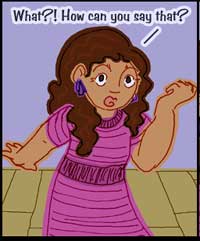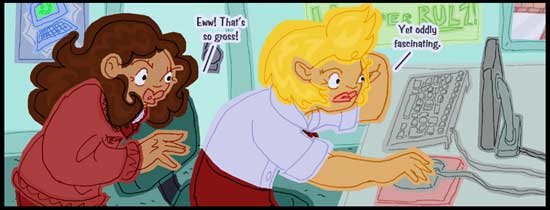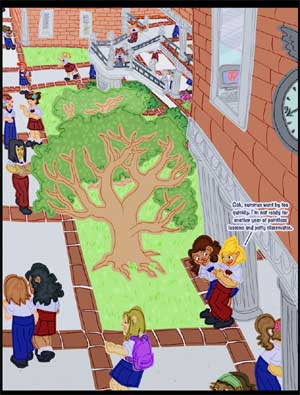Whitney June Robinson is the creator of a wonderfully charming comic about an all girls school called Alma Mater. The comic is written and published to reflect the school calendar with Robinson finishing up the first year of the story this past Spring. With real schools opening their doors this month, Robinson recently kicked off the second year of Alma Mater. It's a visually distinctive comic and Robinson does a fine job of drawing on her own life experience in crafting realistic characters and storylines for the middle school years. I caught up with her recently over emails and asked about the upcoming year of her comic.
 Can you tell us a little about yourself? Where are you from and where are you now?
Can you tell us a little about yourself? Where are you from and where are you now?
Well, I grew up in the suburbs of a major city. During middle and high school, I went to an all-girls' school which served as the model for Blenheim, the school in my comic. After graduating, I went to a women's college back east, and later entered a post-graduate program. Now, having finished with all my studies, I've begun a professional career which is, incidentally, about as removed from comics as possible, but still rewarding.
My interests and hobbies can probably be gleaned from the comic itself. As a student, I participated in a lot of the same activities as my characters. Like most creators, I also tend to put random references to the things I enjoy in my comic.
You're starting your second year of your webcomic Alma Mater. What's in store for the comic? How far ahead are you in plotting out what happens to your characters?
I have written out all of my comics through December, and have planned about one-half to two-thirds of my comics for the spring. There is also a storyline that I've had in the back of my mind for some time, but I won't be able to start it until next year.
Alma Mater will mostly be picking up where it left off in June. Eileen, having abandoned the core group of characters in favor of a new clique, will try to find her place within that group. The other characters' relationships will also face certain challenges over the coming months. I also plan to expand the world of the comic now that the main cast has been established, so new and minor characters will become slightly more prominent. There will also be plenty of comics that simply deal with the day-to-day adventures of being a student, and the frustrations of dealing with arbitrary assignments, tests, and teachers.
In writing the comic, how much do you know about what happens to Eileen later in her life? I guess I'm just curious about how developed she and other characters are when you think about them as opposed to what you get to put into this comic that's about this young period of their lives.
I have a general idea about what will happen to the characters over the next two years, and, to the extent that the characters are based on me, I have an idea about what they'll face after they graduate. Beyond that, I don't want to set the characters' future lives in stone, since it might make it more difficult to let them grow and surprise me over the course of the comic.
However, there are elements of the characters' backgrounds which have not been dealt with in the comic itself. Some of these will probably be revealed in time, but certain things will probably not get covered, or will only be covered in passing.
In an interview with Shaenon Garrity, you described a little bit about your artwork. I'm going to paste it in here:
I use a combination of methods, drawing some elements by hand and using digital editing for other parts of the comic. When I draw, I usually use a basic Pentel pen on sketch paper, although I have used finer pens when I wanted to achieve a particular stylistic effect. I use Photoshop 7 for my digital editing.
I usually begin by drawing rough pen sketches of the characters, which I trace using a light board. I scan the traced drawings, lay out shrunken-down versions of the scans in a rough version of the comic, and write the dialogue. At this time, I also place a pre-done style over the dialogue layers; this automatically creates a line around the text. Later, I create a separate file for each frame, in which I include a blown-up version of the rough comic as a guide.
I begin working on the individual frames by importing my scanned character images, cleaning up errors, increasing the contrast, and using filters to get rid of white space and change the line color. Then, I create a layer for colors underneath the line art. I mostly use the lasso and fill tools to fill in the colors. I repeat this process for foreground and background elements, although I often draw the backgrounds digitally, once I know exactly where the characters are positioned.
Once I finish a panel, I shrink it, place it over the rough version of the comic, and make any necessary revisions to the dialogue.
You know – that sounds like a lot of work. How long does a typical comic take you? Have you made any changes in your approach since then?
 Although I tend to lose track of time when I work on the comic, my style is very time-consuming; an average comic takes several hours to draw. Since my schedule is a little less flexible than it was when I started, I'd like to experiment with ways to make the drawing process more efficient. I have started writing my comics before doing the artwork, rather than working on the drawing first, but I'm not sure that has made a difference in terms of time.
Although I tend to lose track of time when I work on the comic, my style is very time-consuming; an average comic takes several hours to draw. Since my schedule is a little less flexible than it was when I started, I'd like to experiment with ways to make the drawing process more efficient. I have started writing my comics before doing the artwork, rather than working on the drawing first, but I'm not sure that has made a difference in terms of time.
It is a very distinctive style. In the Garrity interview you described it thusly:
Although this wasn't intentional, I've found that the "Alma Mater" style owes a lot to 19th Century Japanese prints as well as the French Impressionists and Post-Impressionists, who were also heavily inspired by Japanese prints. The downward angles, the color schemes, and the use of flat colors are reflected in these sources.
Have you created other comics or art outside of that style? How did you make the decision to apply that style to the Alma Mater webcomic?
There have been examples of other visual styles sprinkled through the comic; for example, I used an old-time comics style to tell a ghost story for last year's Halloween comic. Aside from that, I've put together artwork using a variety of styles, ranging from pictures with thick calligraphic lines to geometric, vector-style images.
When I was putting together a visual style, I started out with a few requirements. I wanted to use a style that was a little sketchy, rather than overly-smooth and geometric, and I also wanted to work in color. Since the comic was fundamentally about a specific environment, I thought it was important to pay some attention to the backgrounds as well. Naturally, the style of the comic has evolved over time, as I've gotten a better feel for the world of the comic.
If you could do someone's else comic for is there one that you would jump at?
I don't know if I'd like to take over someone else's comic; a lot of the comics that I like the best are the product of a particular mindset, and I fear that I would mess things up if I tried to write in the style of certain creators. A one-shot guest comic could be fun to work on, though, and I think just about any comic would be fun to do a guest piece for, given adequate time. Part of the fun of a guest strip is adapting a very different comic to your sensibility while keeping it recognizable, and you could find a way to surprise yourself with just about any comic.
Even though I wouldn't want to draw someone else's comic, it would be fun to try my hand at another genre. For example, I think that an old-fashioned serial adventure comic would be a blast to put together. At one time, I would have loved to work on a fantasy story, but, while I enjoy reading good fantasy comics, I'm not sure that I would want to write a fantasy.
You're now also syndicated through Modern Tales on the web. How has that been and has it helped with building an audience? Do you speak much with editor Shaenon Garrity or other creators connected to the site?
Modern Tales has been pretty good to me; I know I gained a few readers just by virtue of being on the site, and the interviews and other press releases have helped to raise the comic's profile a bit.
Shaenon was very forthcoming with advice and suggestions when I joined Modern Tales, and I've also chatted a little bit with Bellen's Box Brown while we were getting our sites ready to launch on Modern Tales. I've been pretty busy lately, so I've mostly kept to myself. However, I've become more aware of other Modern Tales comics since I joined, and I have done small things to promote my fellow Modern Tales creators from time to time.
I've also been maintaining the comic's WebcomicsNation mirror, and have kept in contact with a few of the creators there. In particular, Tonia Walden of Maxwell the Demon has been very supportive of my comic.

Have you met Joey Manley yet? I'm not sure how much he gets involved with MT now that he has shifted his focus to Webcomics Nation.
I've occasionally commented on the Talk About Comics blog and message board, but I haven't met Joey in person yet.
 How popular is the comic now? What do you know about who your readers are?
How popular is the comic now? What do you know about who your readers are?
I think I had about 3,000 hits per day at the end of the last school "semester." Of course, it's hard to say how that translates into individual readers, or, for that matter, passionate readers. These days, I haven't had the time to follow stats, and I've mostly relied on links, comments, and other feedback as a way to gauge interest.
Unsurprisingly, many of my more vocal readers have a particular connection to the themes of my comic; I've noticed a few teachers, along with students and alumnae from various women's colleges. It also seems like the comic has a few more female readers than male readers, and that the bulk of readers are either college-age or a little older. Nonetheless, there have also been quite a few readers who love Alma Mater but don't fit that description at all.
Any plans to collect the comics in a book?
I think that Alma Mater would be a tricky comic to adapt into a book format for a number of reasons. First, the color scheme, which works on a computer screen, might lose something if it were printed. Second, given the variable formats and the fact that certain comics are very large, it would be hard to compile the comics in a book without chopping some of them up.
One option that I would consider if my comic became incredibly popular would be an annual "Yearbook," which could incorporate individual frames from various comics along with student photos, profiles of clubs, and various other things that you find in school yearbooks. However, there would have to be a substantial demand to justify editing the old content and adding new content, and I don't really think that it's likely to happen.
What are your ambitions for the comic? What do you hope to accomplish in the future?
Right now, I'd like to make sure and keep the strip going at the same pace without shirking my non-comics responsibilities. I don't think it's impossible , but I will have to be more organized.
Thematically, I'd like to see where the characters take me and give them room to grow during the strip's run. I'd also like to give myself room to experiment with Alma Mater, tackling a wide array of themes and thinking of different ways to present individual comics.
Recent Comments